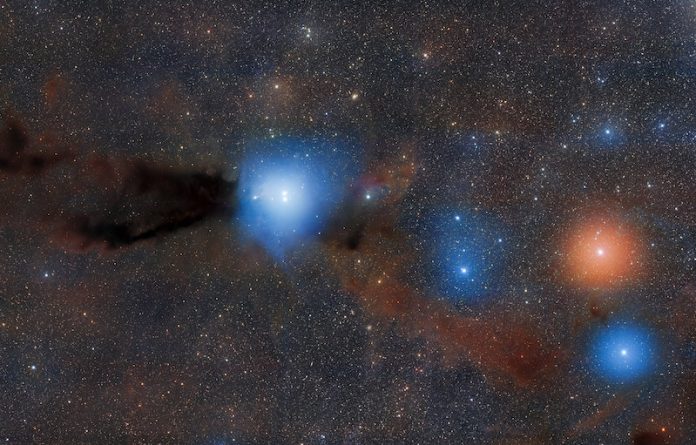
A Brief Introduction to Lupus 3
Picture a massive, star-forming cloud in the depths of the cosmos, known as Lupus 3.
This celestial body has been beautifully captured by the Dark Energy Camera, a remarkable piece of equipment created by the US Department of Energy.
This camera boasts an impressive 570-megapixels and is stationed at NSF’s NOIRLab’s Cerro Tololo Inter-American Observatory, situated in Chile.
The central region of Lupus 3 is breathtaking, featuring a pair of newly born stars bursting out from their “cocoons” made of dust and gas.
These starry infants light up a reflection nebula called Bernes 149. The different areas in this object make it a perfect subject for studying star formation.
When Forces Clash: The Creation of Reflection Nebulae
We witness extraordinary sights when energy and matter collide.
This isn’t just on Earth—where we have phenomena like radiant auroras and intense lightning—but in the vast expanse of space as well.
Here, energy emanating from vibrant young stars and protostars illuminates enormous interstellar clouds of dust and gas. This results in the creation of stunning structures, referred to as reflection nebulae.
Lupus 3, situated about 500 light-years away from Earth, is a stellar example of this. It’s in the direction of the constellation Lupus, which fittingly means ‘the Wolf.’ This interstellar cloud is a hotbed of star formation.
An Intergalactic Nursery: Home to Infant Stars
The scene-stealers in this sprawling nebula are two blue stars, HR 5999 and HR 6000.
These celestial bodies illuminate nearby gas and dust, giving rise to the brilliant blue Bernes 149 reflection nebula. Lupus 3, a dark nebula that sprawls across a backdrop of stars, birthed these stars.
But this cloud is not just an unremarkable, pitch-black blob. It houses a host of baby stars, known as T Tauri stars. Eventually, these infant stars will utilize the materials from Lupus 3 to mature into full-fledged stars.
The Older Siblings: HR 5999 and HR 6000
With an age of about 1 million years, HR 5999 and HR 6000 are the oldest stars in the Lupus 3 region. These stars are pre-main-sequence stars.
That means, even though they’re bright, they’re not yet powered by nuclear fusion, like our Sun. Instead, gravity powers these stars, compressing and heating their internal matter.
They’ve blown away nearby gas and dust, illuminating the remnants and giving birth to the Bernes 149 reflection nebula.
Astronomers initially hoped that discovering the true nature of this nebula would help them find regions of recent or active star formation.
This hypothesis turned out to be correct, with Lupus 3 offering many insights into the early stages of star formation.
Lupus 3: A Part of Something Bigger
Lupus 3 is part of a larger family. It’s one of at least nine clouds within the massive Lupus cloud complex. It stretches across an area of the sky equivalent to about 24 moon-diameters, as seen from Earth.
Thanks to its massive 2.2-degree field of view, the Dark Energy Camera can capture enormous objects like Lupus 3 in a single image.
Combining the DECam’s wide-field capabilities and the light-collecting capabilities of the Víctor M. Blanco 4-meter Telescope’s 4-meter-wide mirror results in sharp, high-resolution images.
Provided by Association of Universities for Research in Astronomy.



